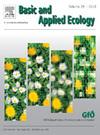极端干旱事件对多肉植物 Sempervivum tectorum L 的克隆繁殖和适应能力的影响
IF 3.5
2区 环境科学与生态学
Q2 ECOLOGY
引用次数: 0
摘要
功能性状被定义为影响生物体性能的性状,即生长发育、繁殖和生存,因此它们通常与适应和调适有关。在这里,我们的目的是研究极端干旱事件对家燕草(Sempervivum tectorum L.)克隆繁殖的影响以及适应恶劣环境的激素机制。我们还探索了与生长和胁迫相关的植物激素作为功能特征的有效性,以评估田间的胁迫适应反应。我们比较了植物(包括莲座母株和新培育的克隆株)对西班牙东北部吉列里山区小悬崖上发生的夏季极端干旱事件的反应。我们采用液相色谱-串联质谱的代谢组学方法,在田间测量了各种胁迫因子,并进行了激素分析。结果表明,在研究期间,克隆繁殖被抑制,并发现从春季到夏季,母本和新克隆的赤霉酸含量增加了 100 倍,同时相对含水量减少,仅降低了 20%。与胁迫有关的生物活性茉莉酸、茉莉酰异亮氨酸与赤霉酸同时增加,而与生长有关的激素,包括生物活性细胞分裂素(2-异戊烯基腺嘌呤和反玉米素)从春季到夏季减少,这与生长停滞一致。结论是,S. tectorum 通过成功激活复杂的荷尔蒙反应,在低水分供应期调整新克隆的招募,并抵御夏季的极端干旱事件(在土壤含水量低于 2% 和温度高于 43 ºC 时防止严重的细胞张力损失),这种反应是该物种在极端气候事件中生存的强大能力的基础。本文章由计算机程序翻译,如有差异,请以英文原文为准。
Impact of an extreme drought event on clonal reproduction and the acclimation capacity of the succulent plant Sempervivum tectorum L.
Functional traits have been defined as those that affect organismal performance, that is growth and development, reproduction and survival, so they have been generally associated with acclimation and adaptation. Here, we aimed to study the impact of an extreme drought event on clonal reproduction and hormonal mechanisms underlying acclimation of houseleek (Sempervivum tectorum L.), a plant adapted to survive harsh environments. We also explored the validity of growth- and stress-related phytohormones as functional traits to evaluate stress acclimation responses in the field. We compared the response of plants, considering both mother rosettes and newly produced clones, to a very extreme summer drought event occurring in small cliffs in Les Guilleries mountains (NE Spain). We measured various stress makers in the field together with hormonal profiling through a metabolomic approach using liquid chromatography coupled to tandem mass spectrometry. Results showed that clonal propagation was arrested during the study period and revealed a 100-fold increase in abscisic acid content from spring to summer both in mothers and new clones, concomitantly with reductions in relative water content, which decreased by 20% only. The stress-related bioactive jasmonate, jasmonoyl-isoleucine increased simultaneously with abscisic acid, while growth-related hormones, including bioactive cytokinins (2-isopentenyl adenine and trans-zeatin) decreased from spring to summer, which was consistent with growth arrest. It is concluded that S. tectorum adjusts recruitment of new clones during periods of low water availability and withstands extreme drought events during the summer (preventing severe cell turgor loss at soil water contents below 2% and temperatures above 43 ºC) by successfully activating a complex hormonal response that underlies the great capacity of this species to survive extreme climatic events.
求助全文
通过发布文献求助,成功后即可免费获取论文全文。
去求助
来源期刊

Basic and Applied Ecology
环境科学-生态学
CiteScore
6.90
自引率
5.30%
发文量
103
审稿时长
10.6 weeks
期刊介绍:
Basic and Applied Ecology provides a forum in which significant advances and ideas can be rapidly communicated to a wide audience. Basic and Applied Ecology publishes original contributions, perspectives and reviews from all areas of basic and applied ecology. Ecologists from all countries are invited to publish ecological research of international interest in its pages. There is no bias with regard to taxon or geographical area.
 求助内容:
求助内容: 应助结果提醒方式:
应助结果提醒方式:


